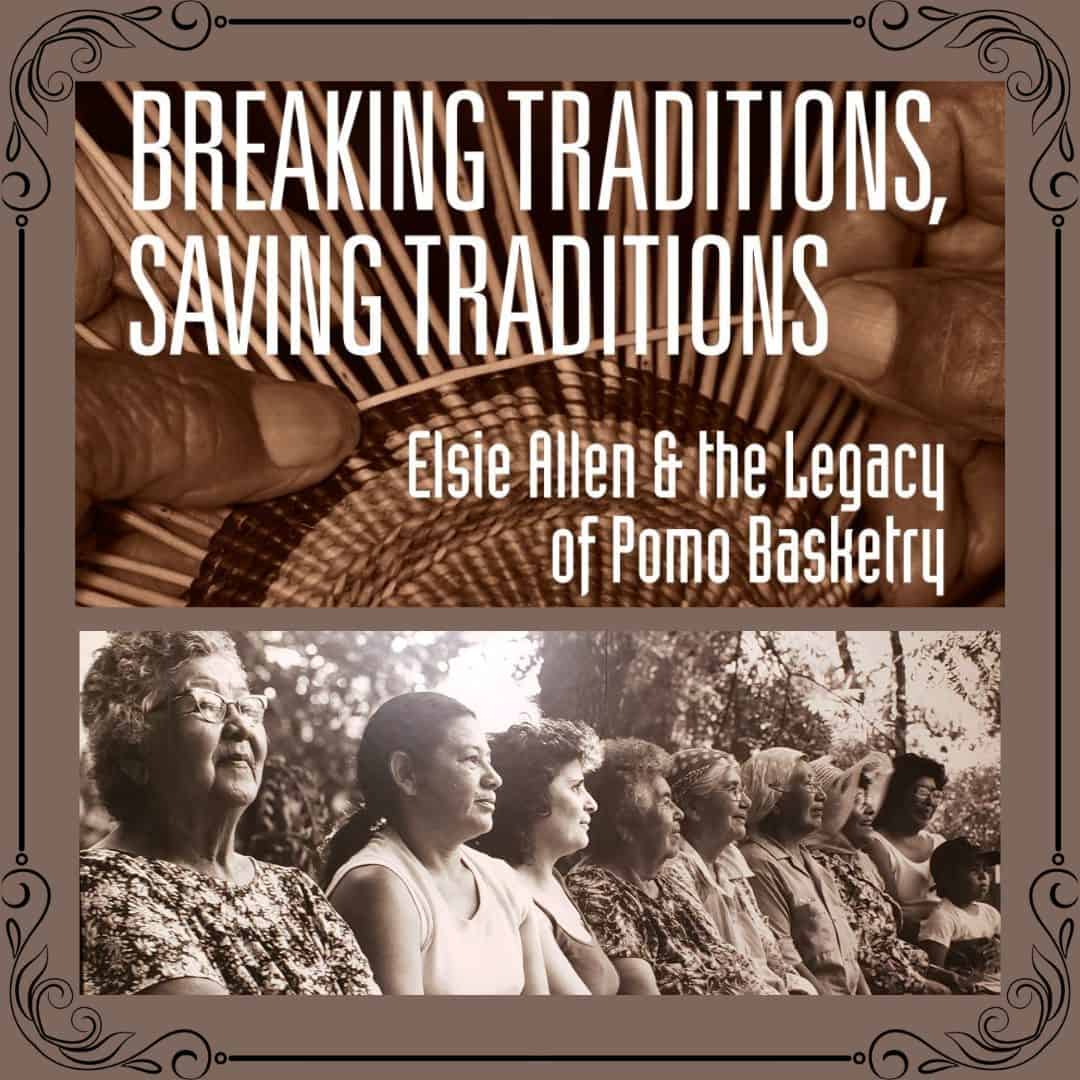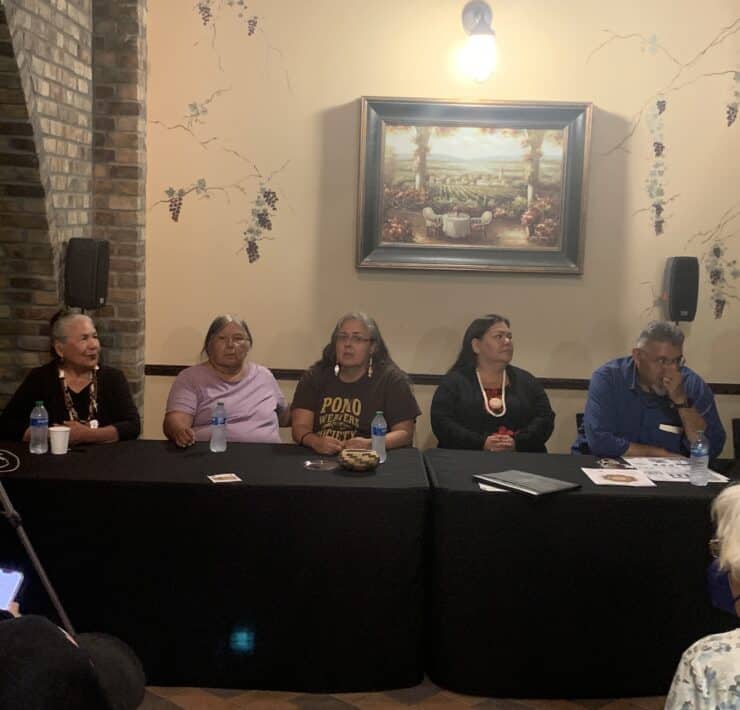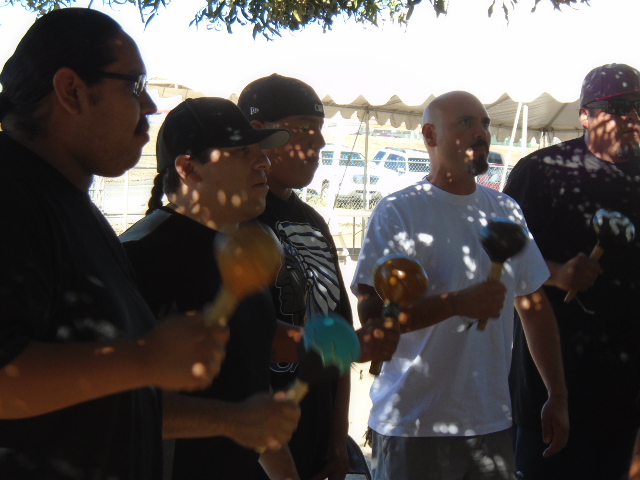“Breaking Traditions, Saving Traditions” at the Multicultural Museum at Santa Rosa Junior College

By Tavi Lorelle Carpenter
I think about culture quite a bit, such as the way it shifts in response to different factors. Or the way cultural suppression is utilized as a tool of oppression. Or how cultural revitalization ties back to traditional knowledge but is being navigated by those of us living in a modern world.
I recently had the opportunity to process acorns at the tribal offices for the Federated Indians of Graton Rancheria, for their upcoming Fall Celebration. I’d never had that opportunity before and there was something very special about not only learning about how to process the acorns but to also sit within the community, working together.
Later, as my family and I sat and talked about traditional practices, we also reflected on the way they can sometimes be disrupted, even in a time of revitalization. I think about this quite a bit because part of living culture is the fact that it isn’t stagnated or frozen in time but truly a living process. At the same time, the exchange across generations is important to maintain. This is why traditions are important, they are time-honored customs connecting past to present.
However, when your cultural values and knowledge are under-attack, tradition can become far more complex and the process of revitalizing and remaking culture can lead to, sometimes heated disagreements. I wonder if part of the “heat” is really grounded in the hurt that comes from not having the ability for culture to have the natural progression it should have had, had it not been disrupted . In truth, this is the kind of conversation that needs to be held on a community level. I certainly consider and think about it quite a bit but I look forward to a time where I can listen to the thoughts of others who are more knowledgeable, with the lived wisdom only time can give you.
I bring this up because it relates back to an exhibition that is currently on display at the Santa Rosa Junior College’s Multicultural Museum. The exhibit is called: “Breaking Traditions, Saving Traditions: Elsie Allen & the legacy of Pomo Basketry”. It opened March 3rd and is up through December 22, 2023.
As I am certain most of you know (or gleaned), Elsie Allen was an incredible basket weaver. This exhibit includes a collection of 130 baskets that are beautifully and expertly woven, spanning from the late 1800s through the 1980s. This collection is unique and rare in that it is the only of its size to have been “created and curated entirely by Native American weavers” and includes significant “ethnographic information on nearly every basket in the collection”. In fact, there is even a QR code at the entrance that takes you to a Google Drive filled with recordings of Annie Lake, Elsie Allen and Salmone Alcantra. A rare opportunity to hear from old-timers of the past, sharing their lived experiences.
Before she passed on, Elsie Allen’s mother, Annie Burke, asked her daughter to not burn her baskets, as was the traditional way. Instead, she asked that her baskets be preserved, Elsie Allen did as she asked, even though it made people critical of her. She also would teach anyone who wanted to learn how to weave. It is because of her that this exhibit is able to be on display, unlike many museums across the world, these baskets were given to the museum by the family. There had been an incident where baskets had been stolen during a break-in, this led to the baskets being given to the museum to ensure Annie Burke’s wish continues to be fulfilled.
Like most museum’s the history of the Santa Rosa Junior College Multicultural Museum is a sordid one. 85 years ago, Jesse Peter was invited by the president of the college to create a museum to exhibit geological samples (in other words, rocks) for the science department. Utilizing a Work Projects Administration (WPA) grant during the New Deal era, the museum would finally open its doors in 1940. The museum housed more than just rocks, as Peter being, in the words of supervisor and curator, Rachel Minor, “a man of his time”, had ‘collected’ quite a few items that were oftentimes taken using “less than ideal methods”. This included California Indian cultural items that are currently in the process of being repatriated. Peter died in 1944, 4 years after the opening of the museum and 6 years after its inception.
The curator role was then filled by Dr. Christina B. Andreini from 1952 until 1959 where it was later filled by Docia Patchett in 1960. It was under Patchett’s leadership, the museum ran weekly children’s tours. However, the 1960s also found the museum to have lost focus and by 1973, the remaining museum items that hadn’t been returned to donors, were quite literally walled up (like a full wall, no door) and the space was now an Art Gallery.
In 1972, William “Bill” Smith (Dry Creek Pomo and Bodega Bay Miwok) founded the Native American Studies department at SRJC and he realized the importance of having a Native American Museum. The administration reluctantly gave approval and it was agreed that the Native American Museum could exist in the back part of the building-the part that had been walled up without a door. It strikes me as rather ironic and indicative of how schools and administrations often deal with Indigenous people, putting up wall after wall. Indeed the administration at SRJC was uninterested in honoring their original agreement until finally in 1975 they finally relented. Rachel Minor told me that Bill Smith quite literally smashed through that wall with a sledge hammer. It would then take significant effort on behalf of Bill Smith, Kathleen Smith (his sister, an artist and author), David Perri (Sonoma State University instructor), Otis Parrish (SRJC instructor), Laura Somersal, Elsie Allen, Mabel McKay and several Native American Studies students to make it an actual viable museum space.

When Bill Smith moved on to his next adventure teaching at Sonoma State University, anthropology instructor Benjamin Foley became the museum’s longest director, from 1979 through the mid 2000s. Eventually the museum would move back into the front part, replacing the gallery and to this day it remains a unique but important museum. It is one of the small handful of museums at a 2-year college and over 90% of its collection has been donated by community members. That is significant.
Its current exhibit showcasing Elsie Allen and truly the legacy of honoring her mother’s request has been received positively throughout the community. Though when I asked if there was any negative feedback, Rachel Minor did say there was still, though very indirect, feedback regarding Elsie Allen’s break in tradition. But I, personally am grateful to Annie Burke, Elsie Allen and their family line that continues to honor Annie Burke. As a person of Pomo descent, I am grateful to have been able to see these beautiful baskets woven by Pomo people.
And I want to share a short story of why these exhibits are important. In elementary school, I was the only Native kid. At five years old I was asked to come to the front of the class and share what it meant to be a Native American. A really big ask of a five year old, even more of a very shy one. It is one of the first memories I have of lying because I didn’t know what to say and I didn’t want to say anything. But I also have a wonderful memory of going to the Oakland Museum and getting to see an exhibit about California Indian people. And do forgive me, but five was a while ago and I don’t remember the exhibit at all. But I do remember feeling proud and maybe more importantly seen, in a good way.
This is why these exhibits are important.
As an adult, I go to these kinds of exhibits or even exhibits celebrating other Native people like at the American Indian Museum in New York City and I feel pride. I feel the importance of knowing who I am and where I am from. In honoring the knowledge given to me from my living elders, given to them by their elders, my ancestors. It’s then I think about how tradition is like an unbroken connection spanning across time. But I don’t think that means it cannot change, or maybe grow is a more accurate way to think about it. Because when I think about tradition, culture, time and the present, I can’t help but think about trees, deeply rooted in the earth but still growing upwards to the sky changing as the seasons come and go.
If you are in the Sonoma County area this fall season, come see this incredible exhibit at the Santa Rosa Junior College Multicultural Museum.
Or make it to the next one, opening on November 3rd and running through January 26th, 2024, comes Roles, Rules & Responsibility: Northern California Two-Spirit Weavers featuring Augustine Granados-Young (Mountain Maidu), Silver Galleto (Pomo, Coast Miwok), Jarred Lincoln-Stremberg (Karuk/Shasta). An opening reception will take place Friday, November 3rd from 4pm-6pm at the Multicultural Museum.
For more information visit: https://museum.santarosa.edu/

This piece was reported and written with the support of an Ethnic Media Outreach Grant, made possible by the Stop the Hate initiative, funded by the California State Library (CSL) in partnership with the California Commission on Asian and Pacific Islander American Affairs (CAPIAA). To learn more about Stop the Hate or to report a hate incident, visit stopthehateca.org.





